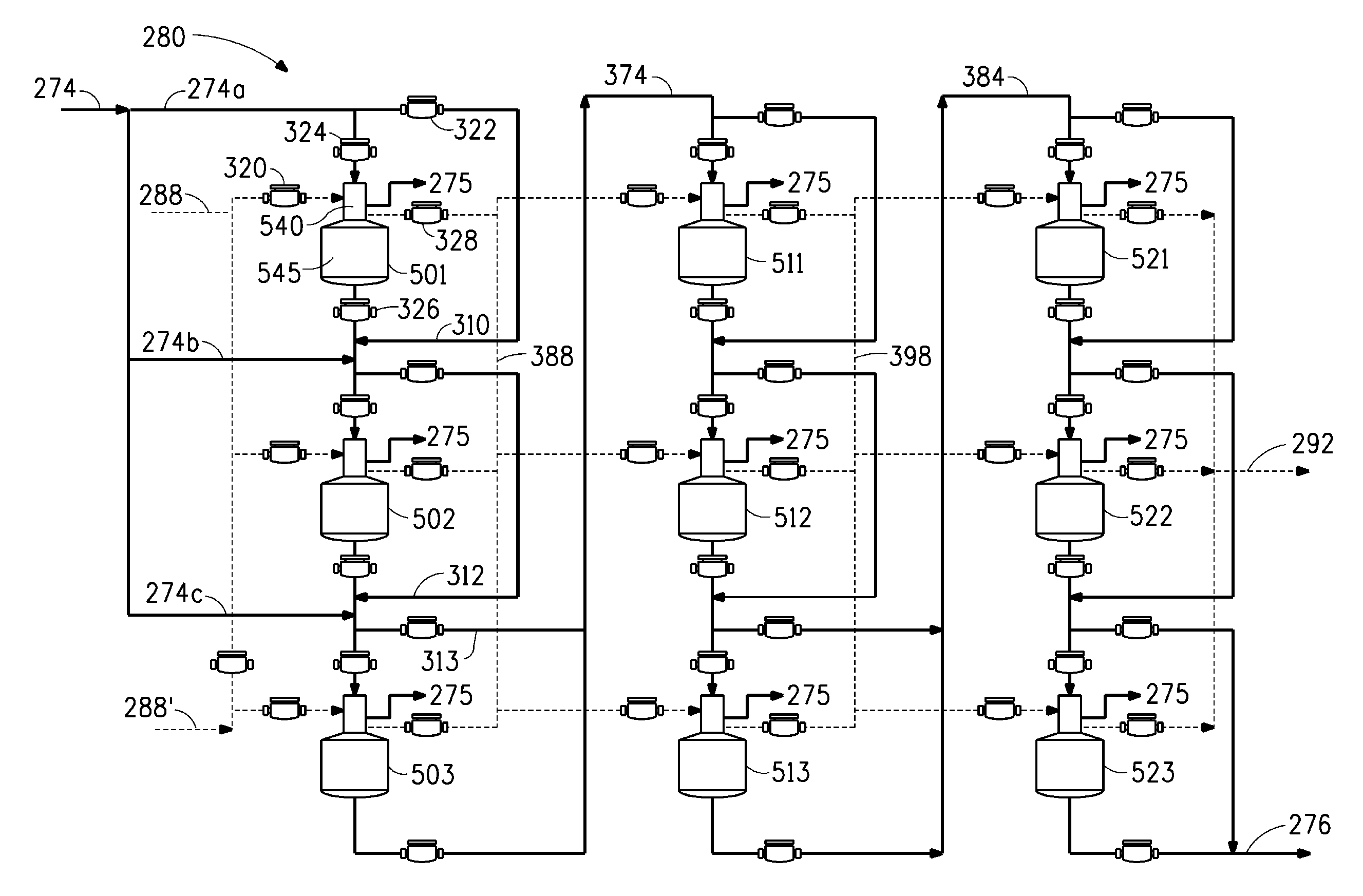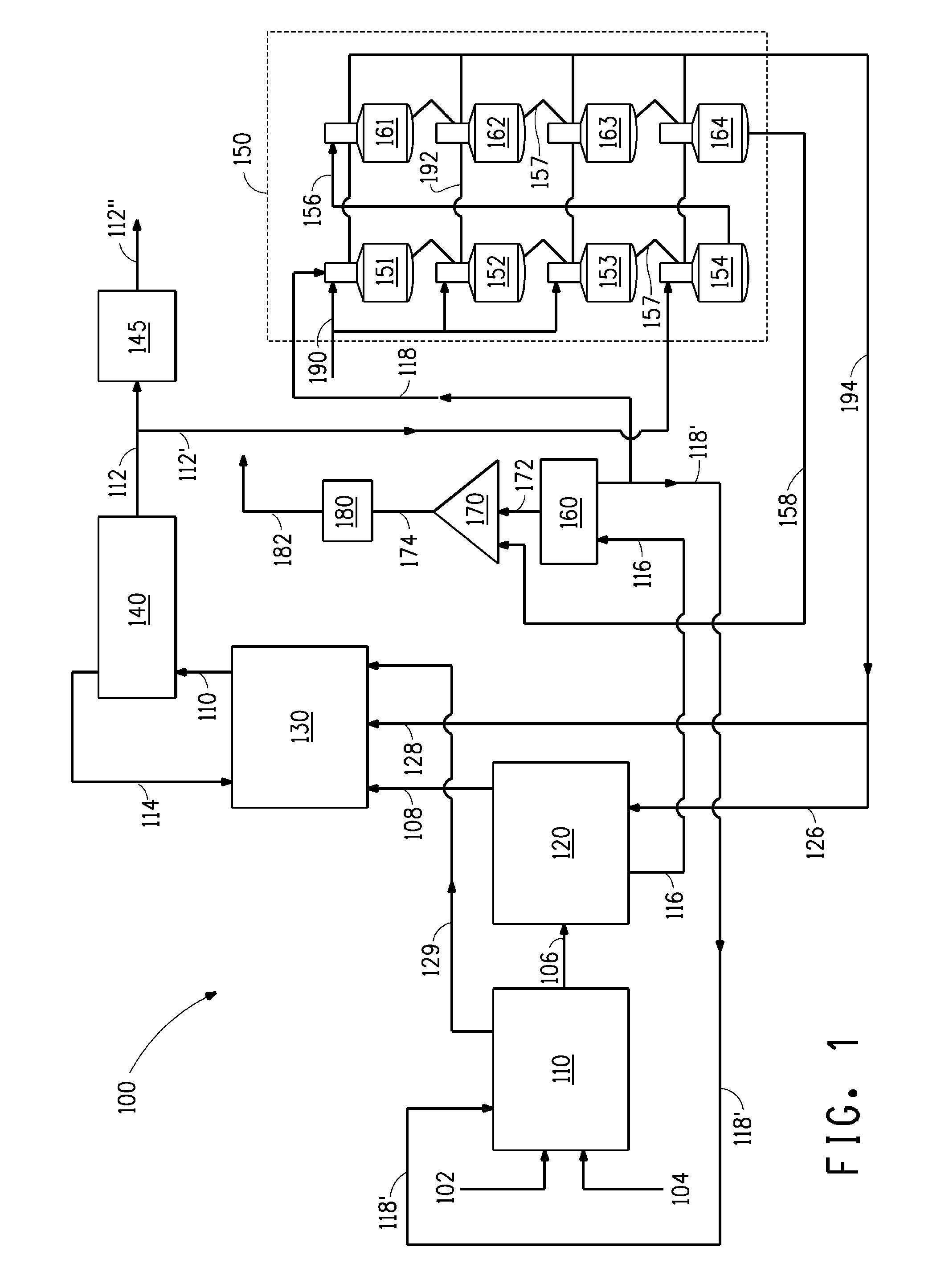Systems and methods for alcohol recovery and concentration of stillage by-products
a technology of alcohol recovery and stillage by-products, applied in the field of alcohol recovery, can solve the problems of not being able to integrate waste heat efficiently with the use of second effect steam described in u.s. pat. no. 7, and the production of other alcohols may not yield a superheated alcohol vapor product that can be integrated as a heat sour
- Summary
- Abstract
- Description
- Claims
- Application Information
AI Technical Summary
Benefits of technology
Problems solved by technology
Method used
Image
Examples
example 1
Ethanol Production Process with Four Train, Double Effect Stillage Evaporation
[0113]Example 1 provides a process model simulation of a “dry grind” ethanol fermentation production process that follows a process schematic for dry grind ethanol plant 100 as shown and described above with reference to FIG. 1. As depicted in FIG. 1, for this model simulation, stream 194 is divided into streams 126 and 128 to provide heat for operation of the beer column 120 and rectifier 130, respectively. The parameters inputted for the simulations of Example 1 are listed in Table 1. Certain dimensions and heat duty results calculated from the process model are also listed in Table 1. These parameters do not include physical property parameters, parameters relating to miscellaneous feeds to the mashed corn feed (e.g., enzymes, ammonia), mash cooking and saccharification parameters, and those related to convergence and other computational options or diagnostics. In the tables that follow, the abbreviatio...
example 2
Butanol Production Process with Three Train, Triple Effect Stillaqe Evaporation
[0115]Example 2 provides a process model simulation of a “dry grind” butanol fermentation production process that follows a process schematic of system 200 as shown and described above with reference to FIGS. 2 and 3. Example 2 was obtained through process modeling using isobutanol as the butanol isomer and oleyl alcohol as the extractant. Similar results would be expected for the analogous cases where 1-butanol or a mixture of 1-butanol and isobutanol was selected as the butanol isomer, due to the similarity of the physical property data for isobutanol and 1-butanol and the heterogeneous nature of the azeotrope between water and these butanol isomers.
[0116]The parameters inputted for the simulations of Example 2 are listed in Table 5. Certain dimensions and heat duty results calculated from the process model are also listed in Table 5. These parameters do not include physical property parameters, paramet...
example 3
Butanol Production Process with Four Train, Double Effect Stillaqe Evaporation
[0118]Example 3 provides a comparative process model simulation of a “dry grind” butanol fermentation production process that substantially follows the process schematic of system 200 as shown and described above with reference to FIG. 2, except that the evaporation system 280 is replaced with a four train, double effect evaporation system 280′ shown in FIG. 4. In the evaporation system 280′ of FIG. 4, thin stillage 274 is concentrated into a syrup 276′ (and then conveyed to mixer 290, see FIG. 2), and the first effect evaporators 151-154 are heated by clean plant steam 288. Second effect steam 292′ generated by the second effect evaporators 161-164 exits evaporation system 280′ (and is then split into lines 294 and 296 which feed steam to beer column 220 and solvent column 230, see FIG. 2). The four train, double effect evaporation system 280′ is configured the same as evaporation system 150 described abo...
PUM
 Login to View More
Login to View More Abstract
Description
Claims
Application Information
 Login to View More
Login to View More - R&D
- Intellectual Property
- Life Sciences
- Materials
- Tech Scout
- Unparalleled Data Quality
- Higher Quality Content
- 60% Fewer Hallucinations
Browse by: Latest US Patents, China's latest patents, Technical Efficacy Thesaurus, Application Domain, Technology Topic, Popular Technical Reports.
© 2025 PatSnap. All rights reserved.Legal|Privacy policy|Modern Slavery Act Transparency Statement|Sitemap|About US| Contact US: help@patsnap.com



